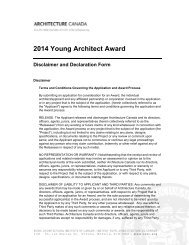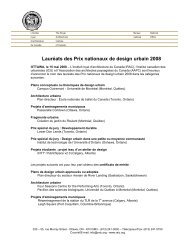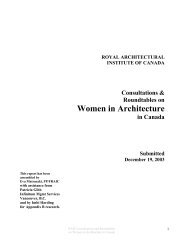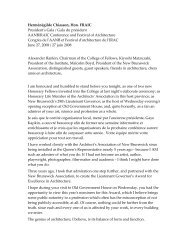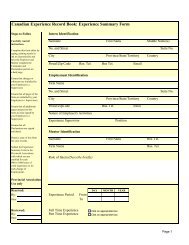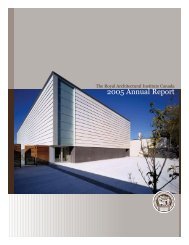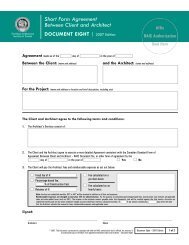Benchmark Study on Green Buildings - Royal Architectural Institute ...
Benchmark Study on Green Buildings - Royal Architectural Institute ...
Benchmark Study on Green Buildings - Royal Architectural Institute ...
Create successful ePaper yourself
Turn your PDF publications into a flip-book with our unique Google optimized e-Paper software.
ebates for homeowners who install photovoltaic panels. These subsidies are now being<br />
phased out, but falling prices for solar generating systems may help the industry despite<br />
these lost subsidies. The cost of residential solar power systems has dropped by about 80<br />
percent in the last decade, to around $6,000 US for each kilowatt of generating capacity.<br />
Since 1999, Japanese home buyers have been able to buy a home that requires almost no<br />
outside energy and that results in a near-zero electricity bill (also known as a zero-utilitycost<br />
house or a zero-energy house). The Hybrid-Z home is built by Misawa Homes, <strong>on</strong>e<br />
of Japan’s largest homebuilders, and MSK Corporati<strong>on</strong>, the Japanese distributor for<br />
Solarex Photovoltaics. The Hybrid-Z home features 20 distinguished and comfortable<br />
living designs and offers either a 6 or 12.5 kilowatt solar electric array that covers the<br />
house’s entire roof. The homes use no natural gas or oil, so all energy use is electric,<br />
including household appliances, cooking facilities, and a water heater. Because of<br />
nati<strong>on</strong>al net-metering, the grid-c<strong>on</strong>nected home sells power to the electric utility at retail<br />
rates when the system generates more than the house uses. The solar modules are<br />
assembled at MSK Corporati<strong>on</strong>’s facility in Nagano and are integrated into the roof at<br />
Misawa’s factory. While it takes three days for Misawa to build the modular home, it<br />
takes <strong>on</strong>ly eight hours to fully install it <strong>on</strong> site. Misawa Homes sold approximately 1,500<br />
Hybrid-Z homes in 1999, and expects these str<strong>on</strong>g sales levels to c<strong>on</strong>tinue. The Hybrid-Z<br />
home is the first residential structure in the world to achieve energy self-sufficiency,<br />
although other manufacturers have since become involved in the zero-utility-cost house<br />
industry. These houses <strong>on</strong>ly emit about 1/5 of the CO 2 emitted by a c<strong>on</strong>venti<strong>on</strong>al house,<br />
and are also subsidized by the New Energy Foundati<strong>on</strong> in accordance with the subsidy<br />
program for residential PV systems. The subsidy ratio of this program is approximately<br />
1/3 of the total installati<strong>on</strong> cost of the solar roof, which works out to about 3 milli<strong>on</strong> Yen<br />
(about $25,000 US).<br />
New Energy Foundati<strong>on</strong> (NEF) programs:<br />
The New Energy Foundati<strong>on</strong> (NEF) of Japan also runs some other subsidy and incentive<br />
programs for the installati<strong>on</strong> of residential photovoltaic power generati<strong>on</strong> systems. From<br />
1994 to 1996, the NEF carried out the “Residential Photovoltaic Power Generati<strong>on</strong><br />
System M<strong>on</strong>itor Project” with a fund from METI. The purposes of the project were: to<br />
promote the mass producti<strong>on</strong> of PV systems and cost reducti<strong>on</strong> by creating initial demand<br />
for the system, and to establish PV systems best suited to c<strong>on</strong>sumer's needs based <strong>on</strong> the<br />
operati<strong>on</strong> data collected by m<strong>on</strong>itoring. Initially a subsidy covered about 50% of the total<br />
cost of the PV systems. Under this program, 3,590PV systems were installed with a total<br />
power output of 13MW, averaging 3.7kW per system.<br />
In 1997, in place of the above m<strong>on</strong>itoring system, the “Program for Infrastructural<br />
Development of Introducti<strong>on</strong> of Residential PV Systems” was started by the NEF. It<br />
aimed for the large-scale introducti<strong>on</strong> of solar power generati<strong>on</strong> systems for private<br />
residences. This program had its budget increased from 4.1 billi<strong>on</strong> yen in 1996 to 11.1<br />
billi<strong>on</strong> yen in 1997. With the expansi<strong>on</strong> of the budget, applicati<strong>on</strong>s for the subsidy<br />
increased substantially and installati<strong>on</strong>s reached 8,329 in 1997. Owing to the reducti<strong>on</strong> in<br />
PV system prices, the subsidy was reduced to about <strong>on</strong>e third of the actual cost, and the<br />
selecti<strong>on</strong> was switched from lot-based <strong>on</strong>e to first-come-first-served basis, so as to accept<br />
87



